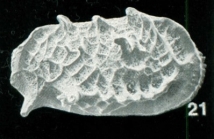WoRMS taxon details
Bradleya ossa Whatley, Downing, Kesler & Harlow, 1984
776381 (urn:lsid:marinespecies.org:taxname:776381)
accepted
Species
marine, fresh, terrestrial
Whatley, R.C., Downing, S.E., Kesler, K. and Harlow, C.J. (1984a) New species of the ostracod genus Bradleya from the Tertiary and Quaternary of D.S.P.D.P. sites in the southwest Pacific. Revista Espanola de Micropaleontologia 16, 265–298. [details]
Type locality contained in Lord Howe Rise
type locality contained in Lord Howe Rise [details]
Description Small, sub-rectangular. Anterior broadly but asymmetrically rounded, more so in LV, with extremity below mid-height....
Etymology L. Referring to the skeleton-like nature of the reticulum.
Description Small, sub-rectangular. Anterior broadly but asymmetrically rounded, more so in LV, with extremity below mid-height. Posterior truncate; large spine developed at postero-ventral cardinal angle in both valves. Dorsal margin straight, anterior hinge ear and postero-dorsal spine developed in LV only. Ventral margin straight to gently convex. Sexual dimorphism distinct. Ventro-Iateral carina strong, flangelike, terminating posteriorly in a prominent ventro-Iateral spine. Ocular ridge distinct. Dorsal carina reduced to a series of 2 or 3 posteriorly directed spines. Bridge highly modified; vertical elements reduced and horizontal elements emphasized, with dorsal element posteriorly laterally expanded into an elongate and curved spine. Remainder of reticulum weak, muri of low relief, distributed over valve surface without apparent preferential orientation. Secondarily reticulate. Fossa at antero-ventral extremity (AS of Liebau 1971) infilled. Valve surfaces densely foveolate. Normal pore conuli distributed as for the genus. Inner lamella broad, avestibulate. Radial pore canals straight simple and distally thickened, false at the antero-ventral extremity corresponding to the fossal infilling. Remainder of internal details as for the genus; posterior terminal tooth of RV distinctly lobate. Juvenile instars demonstrate most of the adult features, bridge modification present as early as A-3, but infilling of fossa A5 present only at maturity. [details]
Etymology L. Referring to the skeleton-like nature of the reticulum.
Etymology L. Referring to the skeleton-like nature of the reticulum. [details]
Brandão, S.N.; Antonietto, L.S; Nery, D.G.; Pereira, J.S.; Praxedes, R.A.; Santos, S.G.; Karanovic, I. (2025). World Ostracoda Database. Bradleya ossa Whatley, Downing, Kesler & Harlow, 1984. Accessed through: World Register of Marine Species at: https://www.marinespecies.org/aphia.php?p=taxdetails&id=776381 on 2025-04-07
Date
action
by
![]() The webpage text is licensed under a Creative Commons
Attribution 4.0 License
The webpage text is licensed under a Creative Commons
Attribution 4.0 License
Nomenclature
original description
Whatley, R.C., Downing, S.E., Kesler, K. and Harlow, C.J. (1984a) New species of the ostracod genus Bradleya from the Tertiary and Quaternary of D.S.P.D.P. sites in the southwest Pacific. Revista Espanola de Micropaleontologia 16, 265–298. [details]
 Present
Present  Present in aphia/obis/gbif/idigbio
Present in aphia/obis/gbif/idigbio  Inaccurate
Inaccurate  Introduced: alien
Introduced: alien  Containing type locality
Containing type locality
From editor or global species database
Description Small, sub-rectangular. Anterior broadly but asymmetrically rounded, more so in LV, with extremity below mid-height. Posterior truncate; large spine developed at postero-ventral cardinal angle in both valves. Dorsal margin straight, anterior hinge ear and postero-dorsal spine developed in LV only. Ventral margin straight to gently convex. Sexual dimorphism distinct. Ventro-Iateral carina strong, flangelike, terminating posteriorly in a prominent ventro-Iateral spine. Ocular ridge distinct. Dorsal carina reduced to a series of 2 or 3 posteriorly directed spines. Bridge highly modified; vertical elements reduced and horizontal elements emphasized, with dorsal element posteriorly laterally expanded into an elongate and curved spine. Remainder of reticulum weak, muri of low relief, distributed over valve surface without apparent preferential orientation. Secondarily reticulate. Fossa at antero-ventral extremity (AS of Liebau 1971) infilled. Valve surfaces densely foveolate. Normal pore conuli distributed as for the genus. Inner lamella broad, avestibulate. Radial pore canals straight simple and distally thickened, false at the antero-ventral extremity corresponding to the fossal infilling. Remainder of internal details as for the genus; posterior terminal tooth of RV distinctly lobate. Juvenile instars demonstrate most of the adult features, bridge modification present as early as A-3, but infilling of fossa A5 present only at maturity. [details]Diagnosis Sub-rectangular species of Bradleya with strong, flange-like ventro-Iateral ridge bearing a large, posteriorly directed spine. Dorsal ridge reduced to a row of 2 or 3 prominent spines. Bridge modified with posterior and dorsal elements, enlarged into a posteriorly curved spine. Remainder of reticulum weak and irregular; secondarily reticulate in the adult. Fossa at anterior extremity (A5 of Liebau, 1971) infilled. [details]
Etymology L. Referring to the skeleton-like nature of the reticulum. [details]

